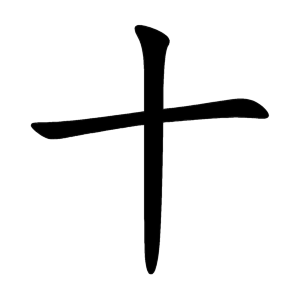十
- ten, the number 10, tenth;
Etymology
It is an ideogram (指事字) originally representing the number 10 with a vertical stroke in ancient times.
Over time, a dot appeared in the middle of the vertical stroke, which then lengthened horizontally, evolving into the current form.
Originally, the character 十 was also used to mean “to stab” or “to cut,” but due to confusion with the number 10 (열 십), the vertical stroke bent to form 七 (seven).
Since 七 was later used as a phonetic loan for 7, the character 切 (to cut) was created by adding 刀 (knife) to 七.
Usage in Korean
This character is used in all words expressing the number 10.
A complex form (variant) is 拾 (to pick up), and another variant is 什 (ten people).
When used as a radical, the shape resembles a cross more closely.
Characters with 十
3 strokes
8 strokes
9 strokes
12 strokes
Words that derived from 十
十
열
십
yeol
sip
Kangxi radical:24
Strokes:2
Unicode:U+2F17
Cangjie input:
- 十 (J)
Composition:
- ⿻ 一 丨
